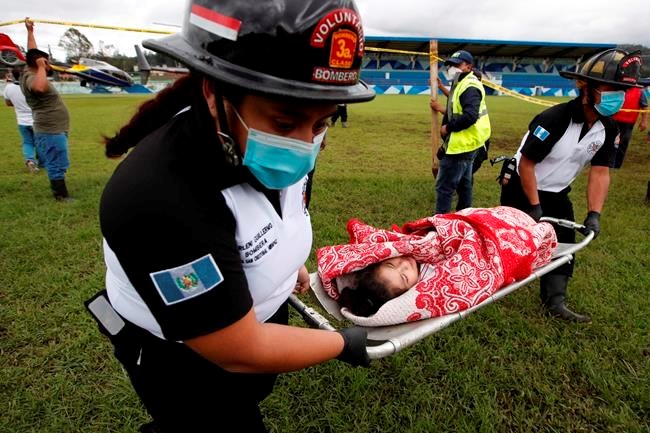PURULHA, Guatemala — Searchers in Guatemala dug through mud and debris looking for an estimated 100 people believed buried by a massive, rain-fueled landslide, as Tropical Storm Eta continued to gain strength Saturday and churned toward Cuba and southern Florida.
The U.S. National Hurricane Center said Eta was located about 165 miles (270 kms) west-southwest of Camaguey, Cuba, Saturday and was moving northeast at 14 mph (22 kph) with winds of 65 mph (100 kph). The storm was expected to be near Cuba Saturday night, and approach the Florida Keys and south Florida late Sunday or Monday.
Tropical storm warnings were issued for central Cuba, southern Florida and the Florida Keys. The hurricane
Florida Gov. Ron DeSantis declared a state of emergency Saturday for eight counties at the end of the state as Eta approached, urging residents to stock up on supplies. South Florida started emptying ports and a small number of shelters opened in Miami and the Florida Keys for residents in mobile homes and low lying areas.
The storms’ threat comes as many streets across South Florida have been inundated by heavy rains and unusual King Tides.
Back in Central America, which Eta reached as a Category 4 hurricane Tuesday before weakening into a tropical depression, authorities from Panama to Mexico were still surveying the damages from flooding and landslides following days of torrential rains. The confirmed death toll was in the dozens and expected to rise.
In Guatemala, where 15 people are confirmed dead but at least 109 are missing, search teams began pulling the first bodies from a landslide in San Cristobal Verapaz, but the work was slow and help was trickling in. Teams first had to overcome multiple landslides and deep mud just to reach the site where officials have estimated some 150 homes were devastated.
In the worst-hit village, Quejá at least five bodies have been pulled from the mud. The Indigenous community of about 1,200 residents consisted of simple homes of wood and tin roofs clinging to the mountainside
Rescue workers used a helicopter to evacuate survivor Emilio Caal, who said he lost as many as 40 family members and relatives. Caal, 65, suffered a dislocated shoulder when the landslide sent rocks, trees and earth hurtling onto the home where he was about to sit down to lunch with his wife and grandchildren. Caal said he was blown several yards (meters) by the force of the slide, and that none of the others were able to get out.
“My wife is dead, my grandchildren are dead,” said Caal from a nearby hospital.
In
Mirian Esperanza Nájera Mejía had fled her home in the dark with her two children and Mejía, her mother. But while she held tight to her children, the current swept away Mejía.
Nájera continued searching desperately for her mother Friday morning. But Mejía’s body was recovered later and taken to the morgue where her relatives identified her.
“When the flooding started, the whole family was leaving the house,” said family friend Nery Solis. “Mirian had her two children and suddenly the current grabbed them and she wasn’t able to get her mom.”
The family transported Mejía’s body to the western city of Copan Friday. Her burial was scheduled for Saturday.
In southern Mexico, across the border from Guatemala, 20 people died as heavy rains attributed to Eta caused mudslides and swelled streams and rivers, according to Chiapas state civil
The worst incident in Mexico occurred in the mountain township of Chenalho, where 10 people were swept away by a rain-swollen stream; their bodies were later found downstream. Mexico's National Meteorological Service said Eta's “broad circulation is causing intense to torrential rains on the Yucatan peninsula and in southeastern Mexico.”
Flooding in the
Hurricane Eta’s arrival in northeast Nicaragua followed days of drenching rain as it crawled toward shore. Its slow, meandering path north through Honduras pushed rivers over their banks and pouring into
The Honduran government estimates more than 1.6 million have been affected.
In Florida, Miami Dade County declared a state of emergency Friday night and also warned a flood watch would be in effect through Tuesday night.
Further south in the Keys, officials were monitoring the storm closely, but had no plans yet to evacuate tourists or residents. They urged residents to secure their boats and encouraged visitors to consider altering plans until Eta had passed.
“Residents need to monitor this storm and be prepared for high tropical storm force sustained winds and hurricane strength gusts,” said Shannon Wiener, Monroe County Emergency Management Director.
___
Associated Press writer Marlon González in Tegucigalpa, Honduras contributed to this report.
Sonia PéRez D., The Associated Press


